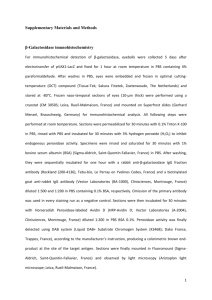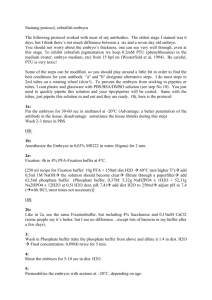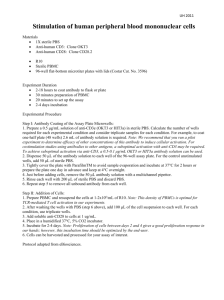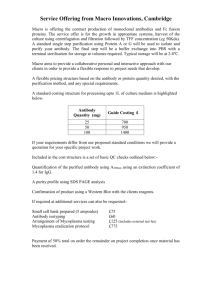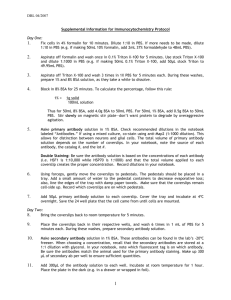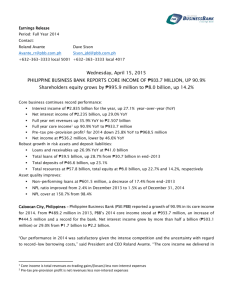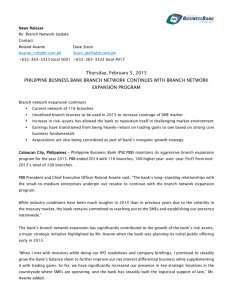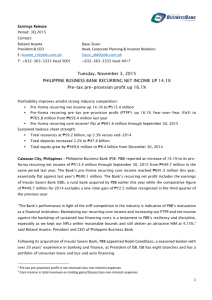Tissue Immunofluores..
advertisement
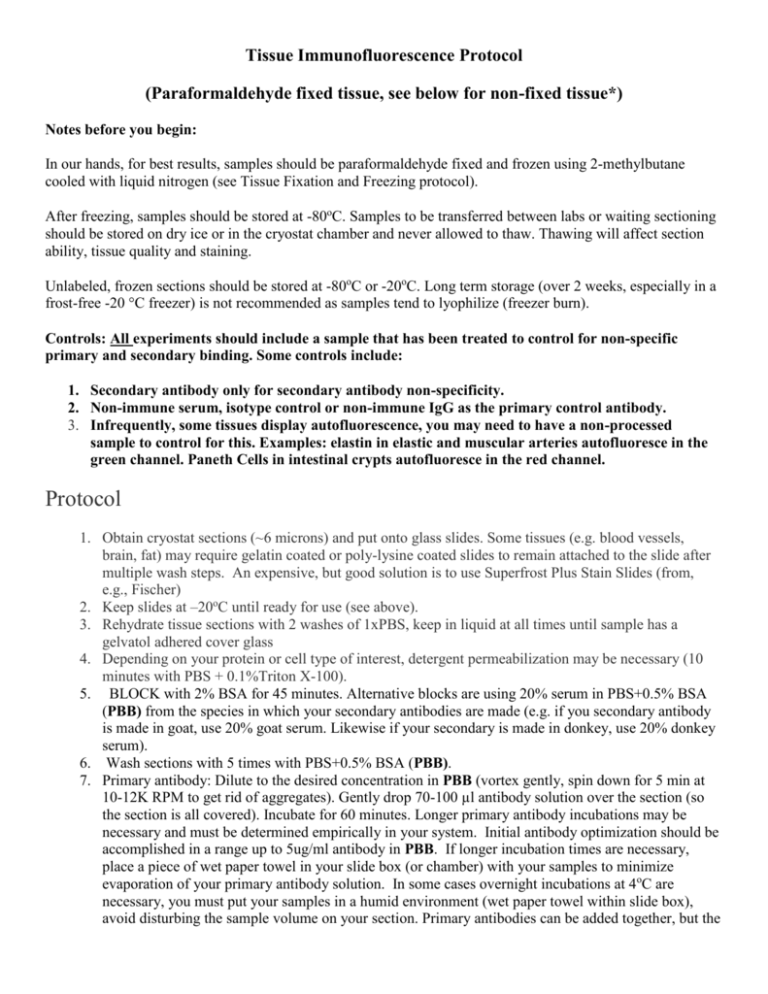
Tissue Immunofluorescence Protocol (Paraformaldehyde fixed tissue, see below for non-fixed tissue*) Notes before you begin: In our hands, for best results, samples should be paraformaldehyde fixed and frozen using 2-methylbutane cooled with liquid nitrogen (see Tissue Fixation and Freezing protocol). After freezing, samples should be stored at -80oC. Samples to be transferred between labs or waiting sectioning should be stored on dry ice or in the cryostat chamber and never allowed to thaw. Thawing will affect section ability, tissue quality and staining. Unlabeled, frozen sections should be stored at -80oC or -20oC. Long term storage (over 2 weeks, especially in a frost-free -20 °C freezer) is not recommended as samples tend to lyophilize (freezer burn). Controls: All experiments should include a sample that has been treated to control for non-specific primary and secondary binding. Some controls include: 1. Secondary antibody only for secondary antibody non-specificity. 2. Non-immune serum, isotype control or non-immune IgG as the primary control antibody. 3. Infrequently, some tissues display autofluorescence, you may need to have a non-processed sample to control for this. Examples: elastin in elastic and muscular arteries autofluoresce in the green channel. Paneth Cells in intestinal crypts autofluoresce in the red channel. Protocol 1. Obtain cryostat sections (~6 microns) and put onto glass slides. Some tissues (e.g. blood vessels, brain, fat) may require gelatin coated or poly-lysine coated slides to remain attached to the slide after multiple wash steps. An expensive, but good solution is to use Superfrost Plus Stain Slides (from, e.g., Fischer) 2. Keep slides at –20oC until ready for use (see above). 3. Rehydrate tissue sections with 2 washes of 1xPBS, keep in liquid at all times until sample has a gelvatol adhered cover glass 4. Depending on your protein or cell type of interest, detergent permeabilization may be necessary (10 minutes with PBS + 0.1%Triton X-100). 5. BLOCK with 2% BSA for 45 minutes. Alternative blocks are using 20% serum in PBS+0.5% BSA (PBB) from the species in which your secondary antibodies are made (e.g. if you secondary antibody is made in goat, use 20% goat serum. Likewise if your secondary is made in donkey, use 20% donkey serum). 6. Wash sections with 5 times with PBS+0.5% BSA (PBB). 7. Primary antibody: Dilute to the desired concentration in PBB (vortex gently, spin down for 5 min at 10-12K RPM to get rid of aggregates). Gently drop 70-100 µl antibody solution over the section (so the section is all covered). Incubate for 60 minutes. Longer primary antibody incubations may be necessary and must be determined empirically in your system. Initial antibody optimization should be accomplished in a range up to 5ug/ml antibody in PBB. If longer incubation times are necessary, place a piece of wet paper towel in your slide box (or chamber) with your samples to minimize evaporation of your primary antibody solution. In some cases overnight incubations at 4oC are necessary, you must put your samples in a humid environment (wet paper towel within slide box), avoid disturbing the sample volume on your section. Primary antibodies can be added together, but the host must be from 2 different species (unless the primary antibodies are directly conjugated with the fluorophore). 8. Wash sections 5 times with PBB. 9. Secondary antibody: Add secondary antibody to the section for 60 minutes (made in PBB, vortex, spin down at 10-12K RPM for 5 minutes to pellet any aggregates – very important). The secondary antibody step should be kept to within an hour. You may add fluor-conjugated phalloidin (for F-actin counterstain) or Draq5 (a far-red nuclear stain from Biostatus) to your secondary solution. Secondaries can be added together if using more than one, but they must be against two separate species. 10. Wash sections with 5 times with PBB. 11. Wash sections with 5 times with PBS to remove the BSA that would bind Hoechst indiscriminately. 12. Add Hoechst stain 30 seconds to stain the nuclei (Hoechst stain=1 mg/100 ml dH2O, Sigma CatNo.B2883). Caution! This substance is carcinogenic and toxic to skin!! 13. Wash sections 3 times with PBS. 14. Adhere cover glass over your sample with gelvatol, place slides horizontal in slide box, and allow cover glass to adhere to slide overnight at 4oC in the dark. Gelvatol is water soluble, if needed coverslip may be gently removed by submerging sample in water and allowing coverslip to lift without resistance from the slide. Recipe for Gelvatol on protocol website. BLOCK=PBS+2% BSA = 2g BSA per 100 mL 1xPBS PBB=PBS+0.5% BSA = 0.5g BSA per 100 mL 1xPBS In some cases non-fixed tissue is used for frozen sectioning. After sectioning, tissue can be fixed in 2% Paraformaldehyde in PBS for 30 min-1 hr*. Alternatively sections can be fixed in cold 100% methanol or acetone (-20oC), which will precipitate the proteins in the tissue. Protocol below: 1. Immerse sections in cold (-20oC) solvent for 10 min. 2. Remove and let air dry. 3. Store these at 4oC (1-2 days) or -20oC (long-term) until processing. 4. Rehydrate tissues with PBS and wash 3 times in PBB. 5. Proceed as above for paraformaldehyde fixed tissues. Note: Tissues fixed in this manner will NOT counterstain with phalloidin. There are many other permutations and other options available when it comes to immunofluorescence protocols. The ones described above are basic and work for most applications. However if you have any questions, or are experiencing problems, please contact a CBI staff member for assistance.
